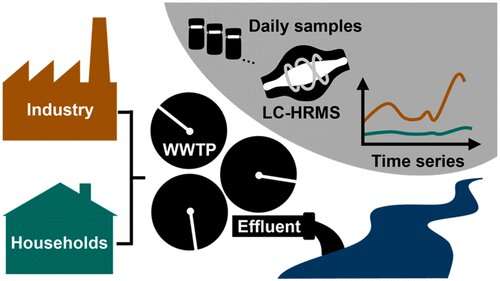Pharma's potential impact on water quality

When people take medications, these drugs and their metabolites can be excreted and make their way to wastewater treatment plants. From there, the compounds can end up in waterways. Wastewater from pharmaceutical companies could start off with even larger amounts of these substances. In ACS' Environmental Science & Technology, researchers report that a single pharmaceutical manufacturing facility could be influencing the water quality of one of Europe's most important rivers.
Wastewater from homes and pharmaceutical manufacturing sites typically goes to treatment plants. Some of the compounds in the water might be biologically active, toxic or persistent, but treatment plants cannot always remove all of the substances before the treated water is discharged into streams or rivers. Little is known about the extent of water contamination from the pharmaceutical industry, in part because companies usually do not disclose details about their manufacturing activities or the identities of the compounds they use. Heinz Singer and colleagues from the Swiss Federal Institute of Aquatic Science and Technology (known as Eawag) wanted to compare compounds in discharged wastewater from two treatment plants near the Rhine River in Switzerland: one that receives only domestic wastewater (WWTPdom) from homes and small businesses, and one that also receives wastewater from a pharmaceutical manufacturing site (WWTPind).
For three months, the team collected daily samples of treated wastewater from the plants and analyzed the substances in them using high-resolution mass spectrometry. Because the pharmaceutical industry typically produces single batches of drugs separated by time, the researchers looked for compounds that showed large variations. They found more of these highly variable compounds in water from WWTPind than from WWTPdom. The team identified 25 compounds as pharmaceutical industry-related substances, including antidepressants and opioids, and their peak levels were much higher in the water from WWTPind than from the plant that only handled domestic wastewater. The researchers also detected several of these substances more than 60 miles downstream in the Rhine River, and their levels correlated with those at WWTPind. These findings indicate that a single company can impact the drinking water resource for millions of people, the researchers say.
More information: Sabine Anliker et al. Assessing Emissions from Pharmaceutical Manufacturing Based on Temporal High-Resolution Mass Spectrometry Data, Environmental Science & Technology (2020). DOI: 10.1021/acs.est.9b07085
Journal information: Environmental Science & Technology
Provided by American Chemical Society


















